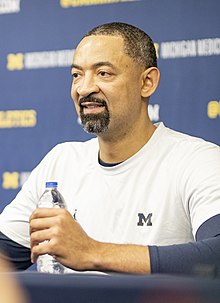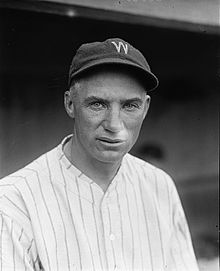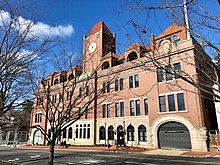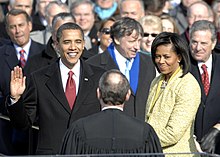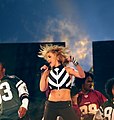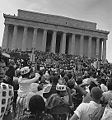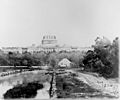Portal:Washington, D.C.
Portal maintenance status: (No date set)
|
The Washington, D.C. portal

Washington, D.C., formally the District of Columbia and commonly known as Washington or D.C., is the capital city and federal district of the United States. The city is on the Potomac River, across from Virginia, and shares land borders with Maryland to its north and east. It was named after George Washington, the first president of the United States. The district is named after Columbia, the female personification of the nation.
The U.S. Constitution in 1789 called for the creation of a federal district under the exclusive jurisdiction of the U.S. Congress. As such, Washington, D.C., is not part of any state, and is not one itself. The Residence Act, adopted on July 16, 1790, approved the creation of the capital district along the Potomac River. The city was founded in 1791, and the 6th Congress held the first session in the unfinished Capitol Building in 1800 after the capital moved from Philadelphia. In 1801, the District of Columbia, formerly part of Maryland and Virginia and including the existing settlements of Georgetown and Alexandria, was officially recognized as the federal district; initially, the city was a separate settlement within the larger district. In 1846, Congress returned the land originally ceded by Virginia, including the city of Alexandria. In 1871, it created a single municipality for the remaining portion of the district. There have been several unsuccessful efforts to make the district into a state since the 1880s; a statehood bill passed the House of Representatives in 2021 but was not adopted by the U.S. Senate. To become law it would have to be passed by the Senate and signed by president; it would have renamed the city Washington, Douglas Commonwealth and shrunk the Federal District to about the size of the national mall.
Washington, D.C. anchors the southern end of the Northeast megalopolis. As the seat of the U.S. federal government, the city is an important world political capital. The city hosts the buildings that house federal government headquarters, including the White House, the Capitol, the Supreme Court Building, and multiple federal departments and agencies. The city is home to many national monuments and museums, located most prominently on or around the National Mall, including the Jefferson Memorial, the Lincoln Memorial, and the Washington Monument. It hosts 177 foreign embassies and serves as the headquarters for the World Bank, the International Monetary Fund, the Organization of American States, and other international organizations. Home to many of the nation's largest industry associations, non-profit organizations, and think tanks, D.C. is known as a lobbying hub, with K Street as the industry center. The city had 20.7 million domestic visitors and 1.2 million international visitors, ranking seventh among U.S. cities as of 2022. (Full article...)
-
Image 1
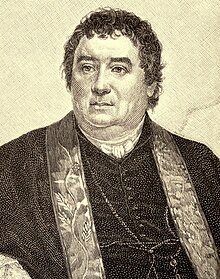
Benedict Joseph Fenwick SJ (September 3, 1782 – August 11, 1846) was an American Catholic prelate, Jesuit, and educator who served as the Bishop of Boston from 1825 until his death in 1846. In 1843, he founded the College of the Holy Cross in Worcester, Massachusetts. Prior to that, he was twice the president of Georgetown College and established several educational institutions in New York City and Boston. (Full article...) -
Image 2On June 19, 1838, the Maryland Province of the Society of Jesus agreed to sell 272 slaves to two Louisiana planters, Henry Johnson and Jesse Batey, for $115,000 (equivalent to approximately $3.25 million in 2023). This sale was the culmination of a contentious and long-running debate among the Maryland Jesuits over whether to keep, sell, or free their slaves, and whether to focus on their rural estates or on their growing urban missions, including their schools. (Full article...)
-
Image 3Howard as head coach of Michigan in 2020
Juwan Antonio Howard (first name /dʒuː.ˈwɑːn/, born February 7, 1973) is an American professional basketball coach and former player who is an assistant coach for the Brooklyn Nets of the National Basketball Association (NBA). He previously served as the head coach of the Michigan Wolverines men's team from 2019 to 2024 before joining the Nets in 2024. (Full article...) -
Image 4
James Aloysius Doonan SJ (November 8, 1841 – April 12, 1911) was an American Catholic priest and Jesuit, who was the president of Georgetown University from 1882 to 1888. During that time he oversaw the naming of Gaston Hall and the construction of a new building for the School of Medicine. Doonan also acquired two historic cannons that were placed in front of Healy Hall. His presidency was financially successful, with a reduction in the university's burdensome debt that had accrued during the construction of Healy Hall. (Full article...) -
Image 5
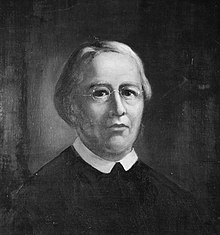
William Feiner SJ (born Wilhelm Feiner; December 27, 1792 – June 9, 1829) was a German Catholic priest and Jesuit who became a missionary to the United States and eventually the president of Georgetown College, now known as Georgetown University. (Full article...) -
Image 6Isabel making landfall in North Carolina on September 18
In Maryland and Washington, D.C., the effects of Hurricane Isabel were among the most damaging from a tropical cyclone in the respective metropolitan area. Hurricane Isabel formed from a tropical wave on September 6, 2003, in the tropical Atlantic Ocean. It moved northwestward, and within an environment of light wind shear and warm waters, it steadily strengthened to reach peak winds of 165 miles per hour (266 km/h) on September 11. After fluctuating in intensity for four days, Isabel gradually weakened and made landfall on the Outer Banks of North Carolina with winds of 105 miles per hour (169 km/h) on September 18. It quickly weakened over land and became extratropical over western Pennsylvania the next day. (Full article...) -
Image 7

John William Beschter SJ (born Johann Wilhelm Beschter; German: [ˈjoːhan ˈvɪlhɛlm ˈbɛʃtɐ]; [needs Luxembourgish IPA] May 20, 1763 – January 6, 1842) was a Catholic priest and Jesuit from the Duchy of Luxembourg in the Austrian Netherlands. He emigrated to the United States as a missionary in 1807, where he ministered in rural Pennsylvania and Maryland. Beschter was the last Jesuit pastor of St. Mary's Church in Lancaster, as well as the pastor of St. John the Evangelist Church in Baltimore, Maryland. He was also a priest at several other German-speaking churches in Pennsylvania. (Full article...) -
Image 8

Samuel A. Mulledy SJ (/mʌˈleɪdi/ muh-LAY-dee; March 27, 1811 – January 8, 1866) was an American Catholic priest and Jesuit who served as president of Georgetown College in 1845. Born in Virginia, he was the brother of Thomas F. Mulledy, who was a prominent 19th-century Jesuit in the United States and a president of Georgetown. As a student at Georgetown, Samuel was one of the founding members of the Philodemic Society, and proved to be a distinguished student, which resulted in his being sent to Rome to complete his higher education and be ordained to the priesthood. Upon his return to the United States, he became the master of novices at the Jesuit novitiate in Maryland, before being named president of Georgetown. He sought to be relieved of the position after only a few months, and returned to teaching and ministry. (Full article...) -
Image 9
Stanley Anthony Coveleski (born Stanislaus Kowalewski, July 13, 1889 – March 20, 1984) was an American right-handed pitcher in Major League Baseball who played for four American League (AL) teams between 1912 and 1928, primarily the Cleveland Indians. The star of the Indians pitching staff, he won over 20 games each year from the war-shortened 1918 season through 1921, leading the AL in shutouts twice and in strikeouts and earned run average (ERA) once each during his nine years with the club. The star of the 1920 World Series, he led the Indians to their first title with three complete-game victories, including a 3–0 shutout in the Game 7 finale. Traded to the Washington Senators after the 1924 season, he helped that club to its second AL pennant in a row with 20 victories against only 5 losses, including a 13-game winning streak, while again leading the league in ERA. (Full article...) -
Image 10

William McSherry SJ (July 19, 1799 – December 18, 1839) was an American Catholic priest and Jesuit who became the president of Georgetown College and a Jesuit provincial superior. The son of Irish immigrants, McSherry was educated at Georgetown College, where he entered the Society of Jesus. As one of the first Americans to complete the traditional Jesuit course of training, he was sent to Rome to be educated for the priesthood. There, he made several discoveries of significant, forgotten holdings in the Jesuit archives, which improved historians' knowledge of the early European settling of Maryland and of the language of Indian tribes there. (Full article...) -
Image 11Look Mickey (also known as Look Mickey!) is a 1961 oil on canvas painting by Roy Lichtenstein. Widely regarded as the bridge between his abstract expressionism and pop art works, it is notable for its ironic humor and aesthetic value as well as being the first example of the artist's employment of Ben-Day dots, speech balloons and comic imagery as a source for a painting. The painting was bequeathed to the Washington, D.C., National Gallery of Art upon Lichtenstein's death. (Full article...)
-
Image 12
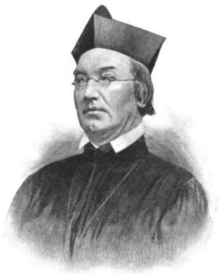
John Early SJ (July 1, 1814 – May 23, 1873) was an Irish-American Catholic priest and Jesuit educator who was the president of the College of the Holy Cross and Georgetown University, as well as the founder and first president of Loyola College in Maryland. Born in Ireland, he emigrated to the United States at the age of nineteen. Upon his arrival, he enrolled at Mount St. Mary's Seminary in Maryland and entered the Society of Jesus, completing his education at Georgetown University in Washington, D.C. (Full article...) -
Image 13

Giovanni Antonio Grassi SJ (anglicized as John Anthony Grassi; 10 September 1775 – 12 December 1849) was an Italian Catholic priest and Jesuit who led many academic and religious institutions in Europe and the United States, including Georgetown College in Washington, D.C., and the Pontificio Collegio Urbano de Propaganda Fide in Rome. (Full article...) -
Image 14
Harmon Clayton Killebrew Jr. (/ˈkɪlɪbruː/; June 29, 1936 – May 17, 2011), nicknamed "the Killer" and "Hammerin' Harmon", was an American professional baseball first baseman, third baseman, and left fielder. He spent most of his 22-year career in Major League Baseball (MLB) with the Minnesota Twins. A prolific power hitter, Killebrew had the fifth-most home runs in major league history at the time of his retirement. He was second only to Babe Ruth in American League (AL) home runs, and was the AL career leader in home runs by a right-handed batter. Killebrew was inducted into the National Baseball Hall of Fame in 1984. (Full article...) -
Image 15M Street elevation in December 2018
The Georgetown Car Barn, historically known as the Capital Traction Company Union Station, is a building in the Georgetown neighborhood of Washington, D.C., in the United States. Designed by the architect Waddy Butler Wood, it was built between 1895 and 1897 by the Capital Traction Company as a union terminal for several Washington and Virginia streetcar lines. The adjacent Exorcist steps, later named after their appearance in William Friedkin's 1973 horror film The Exorcist, were built during the initial construction to connect M Street with Prospect Street. (Full article...) -
Image 16

Stephen Colbert and his wife Evelyn McGee at the Time 100 most influential people awards for 2006
On April 29, 2006, American comedian Stephen Colbert appeared as the featured entertainer at the 2006 White House Correspondents' Association Dinner, which was held in Washington, D.C., at the Hilton Washington hotel. Colbert's performance, consisting of a 16-minute podium speech and a 7-minute video presentation, was broadcast live across the United States on the cable television networks C-SPAN and MSNBC. Standing a few feet from U.S. President George W. Bush, in front of an audience of celebrities, politicians, and members of the White House Press Corps, Colbert delivered a controversial, searing routine targeting the president and the media. He spoke in the persona of the character he played on Comedy Central's The Colbert Report, a parody of conservative pundits such as Bill O'Reilly and Sean Hannity. (Full article...) -
Image 17Enoch Fenwick SJ (May 15, 1780 – November 25, 1827) was an American Catholic priest and Jesuit who ministered throughout Maryland and became the twelfth president of Georgetown College. Descending from one of the original Catholic settlers of the Province of Maryland, he studied at Georgetown College in what is now Washington, D.C. Like his brother and future bishop, Benedict Joseph Fenwick, he entered the priesthood, studying at St. Mary's Seminary before entering the Society of Jesus, which was suppressed at the time. He was made rector of St. Peter's Pro-Cathedral in Baltimore by Archbishop John Carroll, and remained in the position for ten years. Near the end of his pastorate, he was also made vicar general of the Archdiocese of Baltimore, which involved traveling to say Mass in remote parishes throughout rural Maryland. (Full article...)
-
Image 18

Nativity, c. mid-1450s. Oil on wood, 127.6 cm × 94.9 cm (50.2 in × 37.4 in), National Gallery of Art, Washington, D.C.
The Nativity is a devotional mid-1450s oil-on-wood panel painting by the Early Netherlandish painter Petrus Christus. It shows a nativity scene with grisaille archways and trompe-l'œil sculptured reliefs. Christus was influenced by the first generation of Netherlandish artists, especially Jan van Eyck and Rogier van der Weyden, and the panel is characteristic of the simplicity and naturalism of art of that period. Placing archways as a framing device is a typical van der Weyden device, and here likely borrowed from that artist's Saint John Altarpiece and Miraflores Altarpiece. Yet Christus adapts these painterly motifs to a uniquely mid-15th century sensibility, and the unusually large panel – perhaps painted as a central altarpiece panel for a triptych – is nuanced and visually complex. It shows his usual harmonious composition and employment of one-point-perspective, especially evident in the geometric forms of the shed's roof, and his bold use of color. It is one of Christus's most important works. Max Friedländer definitely attributed the panel to Christus in 1930, concluding that "in scope and importance, [it] is superior to all other known creations of this master." (Full article...) -
Image 19William Matthews (December 16, 1770 – April 30, 1854), occasionally spelled Mathews, was an American who became the fifth Roman Catholic priest ordained in the United States and the first such person born in British America. Born in the colonial Province of Maryland, he was briefly a novice in the Society of Jesus. After being ordained, he became influential in establishing Catholic parochial and educational institutions in Washington, D.C. He was the second pastor of St. Patrick's Church, serving for most of his life. He served as the sixth president of Georgetown College, later known as Georgetown University. Matthews acted as president of the Washington Catholic Seminary, which became Gonzaga College High School, and oversaw the continuity of the school during suppression by the church and financial insecurity. (Full article...)
-
Image 20
The first inauguration of Barack Obama as the 44th president of the United States took place on Tuesday, January 20, 2009, at the West Front of the United States Capitol in Washington, D.C. The 56th inauguration, which set a record attendance for any event held in the city, marked the commencement of the first term of Barack Obama as president and Joe Biden as vice president. Based on combined attendance numbers, television viewership, and Internet traffic, it was one of the most-observed events ever by the global audience at the time. (Full article...) -
Image 21
Otto Everett Graham Jr. (December 6, 1921 – December 17, 2003) was an American professional football quarterback who played for the Cleveland Browns in the All-America Football Conference (AAFC) and National Football League (NFL) for 10 seasons. Graham is regarded by critics as one of the most dominant players of his era and one of the greatest quarterbacks of all time, having taken the Browns to league championship games every year between 1946 and 1955, making ten championship appearances, and winning seven of them. With Graham at quarterback, the Browns posted a record of 105 wins, 17 losses, and 4 ties, including a 9–3 win–loss record in the AAFC and NFL playoffs. He holds the NFL record for career average yards gained per pass attempt, with 8.63. He also holds the record for the highest career winning percentage for an NFL starting quarterback, at 81.0%. Long-time New York Yankees owner George Steinbrenner, a friend of Graham's, once called him "as great of a quarterback as there ever was." (Full article...) -
Image 22
Patrick Francis Healy SJ (February 27, 1834 – January 10, 1910) was an American Catholic priest and Jesuit who was an influential president of Georgetown University, becoming known as its "second founder". The university's flagship building, Healy Hall, bears his name. Though he considered himself and was widely accepted as White, Healy was posthumously recognized as the first Black American to earn a PhD, as well as the first to enter the Jesuit order and to become the president of a predominantly White university. (Full article...) -
Image 23
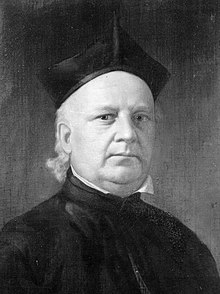
James A. Ryder SJ (October 8, 1800 – January 12, 1860) was an American Catholic priest and Jesuit who became the president of several Jesuit universities in the United States. Born in Ireland, he immigrated with his widowed mother to the United States as a child, to settle in Georgetown, in the District of Columbia. He enrolled at Georgetown College and then entered the Society of Jesus. Studying in Maryland and Rome, Ryder proved to be a talented student of theology and was made a professor. He returned to Georgetown College in 1829, where he was appointed to senior positions and founded the Philodemic Society, becoming its first president. (Full article...) -
Image 24

Charles Henry Stonestreet SJ (November 21, 1813 – July 3, 1885) was an American Catholic priest and Jesuit who served in prominent religious and academic positions, including as provincial superior of the Jesuit Maryland Province and president of Georgetown University. He was born in Maryland and attended Georgetown University, where he co-founded the Philodemic Society. After entering the Society of Jesus and becoming a professor at Georgetown, he led St. John's Literary Institution and St. John the Evangelist Church in Frederick, Maryland. He was appointed president of Georgetown University in 1851, holding the office for two years, during which time he oversaw expansion of the university's library. The First Plenary Council of Baltimore was held at Georgetown during his tenure. (Full article...) -
Image 25
David Hillhouse Buel Jr. (July 19, 1862 – May 23, 1923) was an American priest who served as the president of Georgetown University. A Catholic priest and Jesuit for much of his life, he later left the Jesuit order to marry, and subsequently left the Catholic Church to become an Episcopal priest. Born at Watervliet, New York, he was the son of David Hillhouse Buel, a distinguished Union Army officer, and descended from numerous prominent New England families. While studying at Yale University, he formed an acquaintance with priest Michael J. McGivney, resulting in his conversion to Catholicism and joining the Society of Jesus after graduation. (Full article...)
Neighboorhoods
-
Image 1

Neighborhoods in Washington, D.C.
Neighborhoods in Washington, D.C., the capital of the United States, are distinguished by their history, culture, architecture, demographics, and geography. The names of 131 neighborhoods are unofficially defined by the D.C. Office of Planning. Neighborhoods can be defined by the boundaries of wards, historic districts, Advisory Neighborhood Commissions, civic associations, and business improvement districts (BIDs); these boundaries will overlap. The eight wards each elect a member to the Council of the District of Columbia and are redistricted every ten years. (Full article...) -
Image 2

The U Street Corridor or Greater U Street, sometimes known as Cardozo/Shaw, is a neighborhood in Washington, D.C., located in Northwest D.C. Centered along U Street, the neighborhood is one of Washington's most popular nightlife and entertainment districts, as well as one of the most significant African American heritage districts in the country. (Full article...) -
Image 3
Hillbrook is a neighborhood in Northeast Washington, D.C. It is bounded by Nannie Helen Burroughs Avenue to the north, Brooks Street to the south, 44th Street NE to the west, and Division Avenue to the east. (Full article...) -
Image 4
Brentwood is a neighborhood in Northeast Washington, D.C., Bounded by Rhode Island Avenue NE, Rhode Island Ave-Brentwood Metro Sta Train Tracks NE, Montana Avenue NE, and New York Avenue NE. And is named after the Brentwood Mansion built at Florida Avenue and 6th Street NE in 1817 by Robert Brent, the first mayor of Washington City. He built it as a wedding present for his daughter Eleanor on her marriage as second wife to Congressman Joseph Pearson, and it stood for a hundred years before burning down in 1917. (Full article...) -
Image 5
Fort Davis is a residential neighborhood located in southeast Washington, D.C., on the border between the District of Columbia and Maryland. It is bounded by Southern Avenue, Pennsylvania Avenue SE, and Alabama Avenue SE/Bowen Road SE. (Full article...) -
Image 6

Mount Pleasant is a neighborhood in Washington, D.C., located in Northwest D.C. The neighborhood is primarily residential, with restaurants and stores centered along a commercial corridor on Mt. Pleasant Street. Mount Pleasant is known for its unique identity and multicultural landscape, home to diverse groups such as the punk rock, the Peace Corps and Hispanic Washingtonian communities. (Full article...) -
Image 7
Brightwood is a neighborhood in the northwestern quadrant of Washington, D.C. Brightwood is part of Ward 4. (Full article...) -
Image 8
Greenway is a residential neighborhood in Southeast Washington, D.C., in the United States. The neighborhood is bounded by East Capitol Street SE, Interstate 295 SE, Fairlawn Avenue SE, Minnesota Avenue SE, Pennsylvania Avenue SE, (Full article...) -
Image 9
Woodland is a small residential and industrial neighborhood in Southeast Washington, D.C. Woodland lies in Washington's Ward 8, among the poorest and least developed of the city's wards. Like the neighborhoods around it, Woodland is almost exclusively African American. Woodland is bounded by Ainger Place SE to the north; Alabama Avenue SE and Knox Place SE to the east; Hartford Street SE to the south; and Langston Place SE, Raynolds Place SE, and Erie Street SE to the southwest. Fort Stanton Park forms the northwest and northern border of the neighborhood. (Full article...) -
Image 10
Park View is a neighborhood in Washington, D.C., located in Northwest D.C. The neighborhood is primarily residential with its main commercial corridor of shops and restauarants located along Georgia Avenue. (Full article...) -
Image 11
Douglass is a residential neighborhood in Southeast Washington, D.C., on the eastern side of St. Elizabeths Hospital, on the border of the Congress Heights Metro Station. It is bounded by Suitland Parkway SE, Alabama Avenue SE, and Saint Elizabeth's Hospital Campus. (Full article...) -
Image 12
Bellevue is a residential neighborhood in far Southeast and Southwest in Washington, D.C., United States. It is bounded by South Capitol Street, one block of Atlantic Street SE, and 1st Streets SE and SW to the north and east; Joliet Street SW and Oxon Run Parkway to the south; Martin Luther King Jr. Avenue SE, Shepherd Parkway, 2nd Street SW, and Xenia Street SW to the west. Bellevue was created from some of the earliest land patents in Maryland, and draws its name from a 1795 mansion built in the area. Subdivisions began in the 1870s, but extensive residential building did not occur until the early 1940s. Bellevue is adjacent to a number of federal and city agency buildings. (Full article...) -
Image 13
Good Hope is a residential neighborhood in southeast Washington, D.C., near Anacostia. The neighborhood is generally middle class and is dominated by single-family detached and semi-detached homes. The year-round Fort Dupont Ice Arena skating rink and the Smithsonian Institution's Anacostia Museum are nearby. Good Hope is bounded by Fort Stanton Park(Fort Circle Hiker-Biker Trail) SE, Alabama Avenue SE, Naylor Road SE, and U Street SE. The proposed Skyland Shopping Center redevelopment project is within the boundaries of the neighborhood. (Full article...)
Selected image
-
Image 1Memorial Bridge connects the city across the Potomac River with Arlington, Virginia. (from Washington, D.C.)
-
Image 3City of Washington from Beyond the Navy Yard, an 1833 portrait by George Cooke in the Oval Office in the White House (from History of Washington, D.C.)
-
Image 4Library of Congress(from National Mall)
The "Grand Avenue" or Mall as proposed by Pierre L'Enfant, 1791 -
Image 6Pool after reconstruction (May 2016) (from National Mall)
-
Image 7The Mall following a snow storm (from National Mall)
-
Image 8On September 18, 1783, an engraving of George Washington, known as the First Cornerstone, was placed as the corner stone of the United States Capitol. (from History of Washington, D.C.)
-
Image 9A major bus strike in May 1974 caused huge traffic jams throughout the city (from History of Washington, D.C.)
-
Image 10General Dwight D. Eisenhower received a hero's welcome in the city in June 1945 following the Allied victory in World War II (from History of Washington, D.C.)
-
Image 11Duke Ellington School of the Arts, a public magnet school in the city (from Washington, D.C.)
-
Image 12National Mall, a landscaped park extending from the Lincoln Memorial to the United States Capitol (from Washington, D.C.)
-
Image 13Britney Spears performs during the "NFL Kickoff Live from the National Mall Presented by Pepsi Vanilla" concert, September 4, 2003 (from National Mall)
-
Image 14The Jefferson Memorial and many of D.C.'s other monuments are built in the Neoclassical style. (from Washington, D.C.)
-
Image 16West side of the U.S. Capitol building (March 2019) (from National Mall)
-
Image 17After their victory at the Battle of Bladensburg in 1814, the British Army burned the White House and other buildings during a one-day occupation of Washington, D.C. (from Washington, D.C.)
-
Image 18Civil rights marchers during the March on Washington at the Lincoln Memorial on August 28, 1963 (from History of Washington, D.C.)
-
Image 20US Capitol in the 2010 blizzard (from Washington, D.C.)
-
Image 21The United States Congress began assembling in the new United States Capitol in 1800 after the nation's capital was moved from Philadelphia. (from Washington, D.C.)
-
Image 23National Mall proper and adjacent areas (April 2002). The Mall had a grassy lawn flanked on each side by unpaved paths and rows of American elm trees as its central feature. (Numbers in the image correspond to numbers in the list of landmarks, museums and other features below.) (from National Mall)
-
Image 24The April 9, 1939, concert by Marian Anderson, facing east from the Lincoln Memorial (from National Mall)
-
Image 25Portrait of the Mall and vicinity looking northwest from southeast of the U.S. Capitol, circa 1846–1855, showing stables in the foreground, the Washington City Canal behind them, the Capitol on the right and the Smithsonian "Castle", the Washington Monument and the Potomac River in the distant left. (from National Mall)
-
Image 27The first inauguration of Barack Obama on January 20, 2009, facing west from the Capitol (from National Mall)
-
Image 29Rock Creek Park, the city's largest park, stretches across Northwest. (from Washington, D.C.)
-
Image 30Axis undergoing restoration (October 2015) (from National Mall)
-
Image 31The Aqueduct Bridge crossing the Potomac River, with Northern Virginia in the background and the Chesapeake and Ohio Canal in the foreground (from History of Washington, D.C.)
-
Image 33Eisenhower Memorial at night, 2021 (from National Mall)
-
Image 36With over 30,000 participants, the annual Marine Corps Marathon, held annually in October, is the largest non-prize money marathon in the country. (from Washington, D.C.)
-
Image 38Washington Metro, the second-busiest rapid rail system in the U.S. based on average weekday ridership, is known for its iconic vaulted ceilings (from Washington, D.C.)
-
Image 39Territorial progression of Washington, D.C. (from History of Washington, D.C.)
-
Image 41The Chesapeake and Ohio Canal was extended to Georgetown in 1830. (from Washington, D.C.)
-
Image 44The Northeast Boundary No. 4 marker stone of the original border between the District of Columbia and Prince George's County, Maryland (from History of Washington, D.C.)
-
Image 45This view from the top of the Washington Monument shows rows of elm trees lining the Reflecting Pool (November 2014). (from National Mall)
-
Image 47Georgetown University, founded in 1789, is the city's oldest university. (from Washington, D.C.)
-
Image 48Map of the Mall in 1893 showing the Monument Grounds (with the Washington Monument), Agricultural Grounds (with the Dept. of Agriculture), Smithsonian Grounds (with the Castle and Arts and Industries museum), Armory Square, Public Grounds and Botanical Garden, as well as parts of the recently created "Tidal Reservoir" and "Proposed Park" (from National Mall)
-
Image 491963 March on Washington for Jobs and Freedom on the National Mall facing east from the Lincoln Memorial (from National Mall)
-
Image 50Washington, D.C., police on Harley-Davidson motorcycles escort the March for Life protest on Constitution Avenue in January 2018. (from Washington, D.C.)
-
Image 51The U.S. Capitol dome was under construction during Lincoln's first inauguration on March 4, 1861, five weeks before the start of the American Civil War. (from Washington, D.C.)
-
Image 53The Washington Monument stood in this unfinished form for 25 years before being completed in 1884. (from History of Washington, D.C.)
-
Image 55The Concert for Valor on the National Mall on November 11, 2014, looking west from the U.S. Capitol grounds (from National Mall)
-
Image 56President Abraham Lincoln insisted that construction of the United States Capitol continue during the Civil War. (from History of Washington, D.C.)
-
Image 57The Washington Capitals, an NHL team, and the Washington Wizards, an NBA team, both play at Capital One Arena. (from Washington, D.C.)
-
Image 582009 view from the United States Capitol facing west, over the Grant Memorial and Capitol Reflecting Pool in the foreground, and across the National Mall towards the Washington Monument (from National Mall)
-
Image 59The National Mall was the centerpiece of the 1902 McMillan Plan. A central open vista traversed the length of the Mall. (from National Mall)
-
Image 60The Eisenhower Executive Office Building, built between 1871 and 1888, was the world's largest office building until 1943, when it was surpassed by The Pentagon. (from Washington, D.C.)
-
Image 61The John A. Wilson Building is the headquarters for much of the Government of the District of Columbia, including the offices of the mayor and D.C. Council. (from Washington, D.C.)
-
Image 62The Smithsonian Museum of Natural History was the most visited museum in the U.S. in 2022, with 3.9 million visits. (from Washington, D.C.)
-
Image 63Yetsom beyaynetu at Das Ethiopian Cuisine, one of D.C.'s many Ethiopian restaurants (from Washington, D.C.)
-
Image 64The March on Washington at the Lincoln Memorial Reflecting Pool on August 28, 1963 (from Washington, D.C.)
-
Image 66Metrobus, operated by the Washington Metropolitan Area Transit Authority (from Washington, D.C.)
-
Image 68The Pentagon following the September 11 attacks with the Washington Monument visible in the background (from History of Washington, D.C.)
-
Image 69Ben's Chili Bowl, known for its half-smoke, a historic staple of the city's cuisine (from Washington, D.C.)
-
Image 71Lincoln Memorial Reflecting Pool before reconstruction (April 2010) (from National Mall)
-
Image 73John F. Kennedy Center for the Performing Arts (from National Mall)
-
Image 75Reading Room at the Library fo Congress (from National Mall)
-
Image 76Looking east from the top of the Washington Monument towards the Mall and the U.S. Capitol, 2023 (from National Mall)
-
Image 77The Washington Monument viewed from the Tidal Basin during the National Cherry Blossom Festival in April 2018 (from Washington, D.C.)
-
Image 78Reagan Washington National Airport in Arlington, Virginia is the closest airport to the city among the three major Washington metropolitan area airports. (from Washington, D.C.)
-
Image 79The United States Capitol in 1846, prior to the addition of the current rotunda (from History of Washington, D.C.)
-
Image 80The National World War II Memorial is among the many popular tourist sites located on the National Mall. (from Washington, D.C.)
-
Image 81The Blue Plains Advanced Wastewater Treatment Plant in D.C. is the largest advanced wastewater treatment facility in the world. (from Washington, D.C.)
-
Image 82One Franklin Square, located in Downtown, hosts the headquarters of The Washington Post. (from Washington, D.C.)
-
Image 83Map of racial distribution in the Washington metropolitan area, according to the 2010 U.S. census; each dot represents 25 people: White, Black, Asian, Hispanic or Other (yellow) (from Washington, D.C.)
-
Image 84Map of the District of Columbia in 1835, prior to the retrocession (from History of Washington, D.C.)
-
Image 85A performance of Moulin Rouge! at the Kennedy Center for the Performing Arts (from Washington, D.C.)
-
Image 86The National Mall, including a central pathway through it, the centerpiece of the 1901 McMillan Plan (from History of Washington, D.C.)
-
Image 87Due to limited dining options on the Mall, food trucks are often parked next to tourist-dense locations. (from National Mall)
-
Image 88The Federal Triangle, a historic hub of executive departments of the U.S. federal government (from Washington, D.C.)
-
Image 90The city's African American population has declined since the 1968 riots. (from Washington, D.C.)
-
Image 92Facing east on the National Mall, as viewed near the 1300 block of Jefferson Drive, S.W. in April 2010. Rows of American elm trees line the sides of a path traversing the length of the Mall. (from National Mall)
-
Image 94Westward view from the top of the Washington Monument in 1943 or 1944 during World War II. In the foreground, temporary buildings on the Washington Monument grounds house the Navy's Bureau of Ships. The Main Navy and Munitions Buildings stand to the right of the Lincoln Memorial Reflecting Pool. Temporary buildings to the left of the Reflecting Pool house the Navy's Bureau of Supplies and Accounts. (from National Mall)
-
Image 95Axis after restoration (September 2016) (from National Mall)
-
Image 96An 1814 watercolor illustration of the United States Capitol after the burning of Washington during the War of 1812 (from History of Washington, D.C.)
-
Image 97Eastward view of the National Mall from the top of the Washington Monument in 1918. The three structures and two chimneys crossing the Mall are temporary World War I buildings A, B and C and parts of their central power plant. (from National Mall)
-
Image 102Demonstrators marching down Pennsylvania Avenue towards the United States Capitol on January 6, 2021 (from History of Washington, D.C.)
-
Image 103Washington Monument and the White House. Since 1961 the city's residents can vote for the President and Vice President, who is also the President of the Senate (from Washington, D.C.)
-
Image 104The southern portion of the National Mall in 1863 during the American Civil War (from History of Washington, D.C.)
-
Image 109Construction of the Washington Metro on Connecticut Avenue in 1973 (from History of Washington, D.C.)
-
Image 110The Library of Congress, the world's largest library with more than 167 million cataloged items and the nation's oldest cultural institution (from Washington, D.C.)
-
Image 111Rows of young American elm trees on the National Mall, looking east from the top of the Washington Monument, circa 1942 (from National Mall)
-
Image 112The city's license plate calls for an end to taxation without representation. (from Washington, D.C.)
-
Image 113The Vietnam Veterans Memorial, designed by Maya Lin, was initially controversial for its lack of heroic iconography, a departure from earlier memorial designs. (from Washington, D.C.)
-
Image 114A panel discussion at the American Enterprise Institute, one of D.C.'s many think tanks (from Washington, D.C.)
-
Image 115The National Gallery of Art was the most visited art museum in the United States in 2022. (from Washington, D.C.)
-
Image 116D.C. is on the north side of the Potomac River, and is surrounded on three side by Maryland. Virginia lies across the river to the south-west (from Washington, D.C.)
Did you know...
- ... that after Michael Jordan was fired by the Washington Wizards, he wanted to move the Capital Classic from the Washington, D.C., area to New York?
- ... that Ron Brown, the United States secretary of commerce, leased equipment to a TV station in Washington, D.C., whose owner turned out to be his lover?
- ... that a coconut tree meme drove sales of piña coladas in the Washington, D.C., area?
- ... that Bicentennial Capitol Mall State Park, modeled on the National Mall in Washington, D.C., was created to commemorate the 200th anniversary of the statehood of Tennessee in 1996?
- ... that Leonardo DiCaprio was set to star in the film adaptation of Leonardo da Vinci?
- ... that the music for the Norse Lands DLC of Kingdom Two Crowns utilizes the hurdy-gurdy and moraharpa?
In the news
- 6 November 2024 – 2024 U.S. elections
- U.S. Vice President and Democratic Party candidate Kamala Harris concedes defeat to Donald Trump in a speech at Howard University in Washington, D.C., stating that she and U.S. President Joe Biden will commit to a peaceful transition of power. (Time)
- 17 September 2024 – Ituri conflict
- CODECO militants kill ten civilians in an overnight attack on a Hema village in Ituri Province, Democratic Republic of the Congo. Some of the victims were beheaded, according to local authorities. (Reuters)
Categories
- Select [►] to view subcategories
Topics
| Topics | |
|---|---|
| Government | |
| Services | |
| Society | |
| History |
|
Related portals
Related WikiProjects
Associated Wikimedia
The following Wikimedia Foundation sister projects provide more on this subject:
-
Commons
Free media repository -
Wikibooks
Free textbooks and manuals -
Wikidata
Free knowledge base -
Wikinews
Free-content news -
Wikiquote
Collection of quotations -
Wikisource
Free-content library -
Wikispecies
Directory of species -
Wikiversity
Free learning tools -
Wikivoyage
Free travel guide -
Wiktionary
Dictionary and thesaurus
- Pages using Template:Post-nominals with customized linking
- Pages with German IPA
- Portals with undated maintenance templates
- Automatically maintained portals with listed maintainers
- Portals with untriaged subpages
- All portals with untriaged subpages
- Portals with named maintainer
- Automated article-slideshow portals with less than 2 articles in article list



